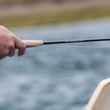I love Irish whiskey. Perhaps it’s the Kearns lineage that bleeds through the mishmash of English Hunts and German Garretts and Mullers that forged the American mongrel I am today, but of all the whiskeys (or whiskies—more on that in a bit), I find Irish the most palatable.
It’s a fine spirit, a sipping drink, almost regardless of general “quality.” The really good stuff—the Teeling, Redbreast and Green Spot—are elixirs that should never sniff a mixer and are most often tasted neat (you might be okay with a globe of ice, though purists out there would scoff at the idea). But this is the Pandemic of 2020, possibly one of several we’ll be telling our grandkids about, given the general havoc we’ve wreaked on the planet and the propensity of wet markets still in existence today. And we’re fly fishers. We’ve borrowed against our retirement to buy the fastest fly rods and the warmest waders sewn with gold-flecked fleece shorn from the finest lambs (if you’re reading this in an Irish accent, you’re doing it right).
And, judging from the state of the market these days, we’d all be wise to drop our eyes to the middle shelf, where a decent bottle of Irish to lubricate a night spent in self-isolation at the tying vise can be still found. Think Jameson. Bushmills. And what’s likely my favorite: Tullamore D.E.W. (no, not “Dew.” The name is derived from the initials of the distillery’s first general manager and later the owner of the distillery in the Tullamore, Daniel E. Williams). This is the stuff that can be enjoyed without eschewing a visit to the big-box store in fruitless search of Charmin or two rolls of Bounty. There are several others, but this could be called The Big Three.
What makes Irish whiskey Irish?
First, know your whiskey history. The first whiskey distillery ever officially licensed was Bushmills in 1608 in Northern Ireland. Yes, snooty scotch drinkers, Irish whiskey was licensed first.
More Like This
Second, Irish whiskey uses a blend of both malted and unmalted barley in the pot-still phase. Scotch is strictly a malted barley beverage.
Third, the blend of barleys in Irish whiskey is dried over a kiln and then triple-distilled. The malted barley in scotch is dried over a peat fire, which gives scotch its patented earthy flavor. And that’s great, if you like the taste of dirt (I’m kidding, mostly). Also, the vast majority of scotch is double-distilled.
Finally, there’s the spelling itself. Irish whiskey and Scotch whisky are spelled differently. Here’s a little cheat-code. If the country home to the whiskey (or whisky) distillery has an “E” in its spelling, the proper spelling for that nation’s brown liquor is whiskey, with an “E.” No “E” in the name of the country? No “E” in whisky. Scotland. No “E.” Whisky. Ireland. An “E.” Whiskey. Another weird note: scotch, when used by itself in a sentence, is not capitalized. But when you put scotch before whisky in a sentence (“I bought 200 shares of Apple while drinking some really pricey Scotch whisky”), it is, indeed capitalized.
Confused yet?
Both spirits are aged in barrels, often for many years. Of late, Irish distillers have taken to aging their product in second-hand oak, often used previously for beer or even other spirits. If you’re a whiskey drinker, you’ve likely noticed the Jameson Caskmates line of whiskeys that are aged in once-used beer barrels, and Bushmills is offering a similar line (Black Bush, Red Bush, etc.). Tullamore? It’s been triple-aged for years, first in a regular cask, then in a second-hand bourbon cask and finally in a second-hand sherry cask.
I tend to associate Irish whiskey with a more proletariat existence. It could be that my ancestors from County Mayo arrived in America with little but the shirts on their backs, and were greeted with general disdain by the mostly English-bred populous at the time. Or it could be that, for some reason, really good scotch costs more than really good Irish (generally speaking).
And, as a former newspaper journalist on a pretty tight budget, I reached for the cheaper stuff. Turns out, I liked it more, anyway.
And here’s why: It’s smoother and more mellow, with a sweeter finish. Scotch is earthy and admittedly more complex, at least according to my palate. It also has a distinct burn and a more “grabby” finish, almost as if it fights its way down your gullet. I don’t hate it. I just don’t love it.
So, eyes forward (I suppose you can look to the top shelf and dream of a post-pandemic world, but for now, and as long as liquor stores are open, focus on the $25-$30 price-per-bottle shelf and envision one of these bottles resting on the desk next to your tying vise). Here’s your guide to middle-shelf Irish whiskeys that’ll help ward off the chill and get you through the existential crisis upon us. And think of all the flies you’ll have on hand when you can finally leave the house.

Jameson
No, not Jamesons or Jameson’s. Singular. This is probably the most popular go-to, bar-ordered Irish whiskey in the country, and in its basic form (don’t go all Caskmakes on me, please), it’s a fine, drinkable Irish whiskey with a solid history for quality and consistency. It features that bright Irish whiskey hue, a smooth and drinkable taste and a clean finish.
It’s also known as “Catholic whiskey,” because it’s distilled in Cork. It’s main competitor, Bushmills, is distilled in Northern Ireland in the United Kingdom, and is often referred to as “Protestant whiskey.” So, if Irish church politics matter to you in the least, there’s that.
My liquor cabinet almost always has Jameson at the front and center.

Bushmills
As I noted, this is the oldest licensed whiskey distiller anywhere—there’s something pretty cool about being able to say that they’ve distilled whiskey along the River Bush for more than 400 years, right? And I like “Protestant” Bushmills, but it probably wouldn’t make my top three. It does come in a handsome bottle, so that may be why I tend to get a lot of Bushmills as gifts (ever want to fill up your liquor cabinet? Have an Irish whiskey-themed birthday party).
The spirit gets its name from the local river and the grain mills that provide the malted barleys for the product. Bushmills is a clean drink, and I find it quite a bit bolder (more harsh?) than Jameson. It’s good over rocks, but I don’t like to drink it neat. It’s just a bit much for me.

Tullamore D.E.W.
Distilled (three times, mind you) smack-dab in the center of the country, it doesn’t get any more Irish than Tullamore. It’s been distilled since 1829 and in 2014, it moved to a new distillery in the community of Tullamore.
I really enjoy Tullamore—it’s likely my favorite from the “attainable on a budget” shelf at the Idaho State Liquor Store. It’s also light and smooth enough to go in a flask for a quick sip—neat—on the water. On the rocks, it's heavenly. I think the final aging in the sherry cask gives Tullamore its unique finish—it’s softer, smoother and cleaner than most other brands. When I think about drinking Irish whiskey, I think about Tullamore.

Quiet Man
A relative newcomer on the “middle-shelf” scene, Quiet Man is a nice blended spirit that uses 20 percent single-malt, a relatively unique claim among Irish whiskey brands. It’s distilled in Derry, Northern Ireland, and isn’t sourcing it’s own spirits yet (it’s buying whiskey from off the still from other distillers and maturing them in first-pour American bourbon barrels), but the company claims that the first batches came off their own stills in 2018, which means they’re aging their first in-house whiskey as you read this.

Proper 12
Owned by Conor McGregor (yes, that Conor McGregor), Proper 12 is a solid Irish whiskey that might actually be a bit sweeter than some of the others listed here. It does have a honey/vanilla character that’s more obvious than other offerings, and it’s a solid drink over ice.
I got my first bottle of Proper 12 as a gift just over a year ago. Since then, I’ve returned to the label a few times—I like to drink it while I’m doing something: tying flies, writing, researching. It’s not an overpowering whiskey. Like Quiet Man, it’s aged in American bourbon barrels.

Powers
Distilled since 1791, Powers whiskey has long been a staple among discerning Irish whiskey drinkers, and there are many who swear by its drinkability and overall quality. Truthfully, it is good whiskey, even though it doesn’t often turn up as a true favorite here in the States.
I find Powers to be bold and full of complex flavor—even its color is richer, almost a mahogany. That may because both the second and third maturation stages are both done in American bourbon casks, or it may because the distiller discards a higher percentage of the top and tail (the very first liquid to drain from the still and the very last—both parts of the top and the tail often have more impurities than the main portion of the distillate) than rival distillers, leaving more body for the cask and, eventually, the bottle.
It’s also a good bargain—you’ll find it sitting on the shelf next to Jameson, Bushmills and Tullamore.

Paddy’s
I love that this venerable Irish whiskey brand is actually considered “bottom shelf” by many liquor retailers. Paddy’s is a quality whiskey—and you can get a bottle for $20. It wasn’t available in most of the U.S. until 2012, so it’s still something of a newcomer to the American drinker. Add in that it’s found on the shelf below Jameson, Tullamore and Bushmills, and I think a lot whiskey drinkers consider it to be less than superior.
I would put a glass of Paddy’s on the rocks up against a tumbler of Jameson any day, and be perfectly happy being told I could drink one, but not the other. Paddy’s traces its recipe back to 1779, but it wasn’t always called Paddy’s. In fact, the name of the beverage sold in clear glass bottles today is named for the man who sold his product in pubs in the early 1900s, Patrick J. O’Flaherty.
In the Irish whiskey world, Paddy’s might be the best bargain there is. Good stuff. Good price.
The final word
If you’re new to Irish whiskey, any of the brands above would be a good place to start. There are, for certain, some very pricey Irish whiskey brands out there, and the Big Three (Jameson, Bushmills and Tullamore) are doing their best to push their premium products on their loyal customers bases.
But, honestly, there’s no need to start drinking Irish whiskey and stop buying nice fly rods. Affordability and quality go hand-in-hand when it comes to Ireland’s whiskey offerings. If you’re really interested in the Irish distilling craft, from a drinker’s perspective, buy a single bottle each of Jameson, Bushmills and Tullamore. You don’t have to drink glasses of all three in a single sitting (but, hey, we are self-isolating, right?), but you might find that the subtle differences don’t require you to pick a favorite.
You’ll find, despite the general commonalities in the Irish distilling craft, that not all Irish whiskeys are created equally. But I’ve also found that certain brands are good for certain occasions.
For instance, my flask in my fishing vest brims with Tullamore—I find it drinkable while fishing (in general moderation, of course). Jameson is the Irish I’ll pull out of the cabinet when I have company—it’s a very tasty sipping whiskey that everybody seems to like, and nobody really seems to despise. And a bottle of Paddy’s will do in a pinch, and when I’m being especially budget-conscious. Drinkable and cheap. Music to my ears.
As we endure the Pandemic of 2020, largely by not going out and not going fishing, we can at least tip a glass of Irish whiskey and look hopefully a time in the not too distant future, when the coronavirus outbreak subsides and we’ll be able to enjoy both the fishing and a sip of brown liquor with our friends again.
Here’s to you, my shut-in friends. May your self-isolation result in dozens of freshly tied flies and a few warm buzzes thanks to the fine distillers of the Emerald Isle.






























Comments
TJW replied on Permalink
Chris - this was great, thanks for the information. Really like it. If I could give a blatant plug to Jack Ryan Whiskey (the e means Ireland, as you taught me). My distant relatives own the distillery and distribution.
Very smooth, right in line with Proper 12, and perhaps even Red Breast.
You might enjoy it
Chris replied on Permalink
Thanks for the tip! I'll give it a whirl if I can find it on the shelves here in Idaho!
Jim K replied on Permalink
Thanks for a really nice article. I didn't know some of the history and found it interesting. Will have to try the D.E.W. While not in the price range addressed, my favorite is Redbreast neat. One of the few Irish or Scotch products that I truly like neat.
Chris replied on Permalink
I'm with you! I generally like a little ice to slowly dilute the burn, but the D.E.W. is a solid neat drink.
Fred H replied on Permalink
Well said Chris!
We must have similar DNA. You are the first person to write Paddy's in that i know of. Lets hope it stays on the shelf below for us to enjoy.
Thanks for the write up.
Chris replied on Permalink
I debated the merits of Paddy's ... what if the distiller catches on and adds a couple bucks to the price!? :)
Chris replied on Permalink
Oh, and one more "bottom shelf" brand to try... Two Gingers. Not half bad.
Christopher Lane replied on Permalink
On a recent trip to visit a old and dear friend (who just happens to be Irish), we spent a few days reminiscing, playing our guitars, smoking a few cigars, and very easily draining a bottle of Tullamore DEW.
Tis like mothers milk.
Chris replied on Permalink
Right? Underappreciated elixir, to be sure.
Pages